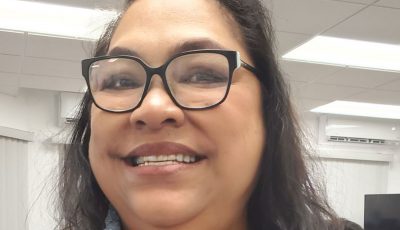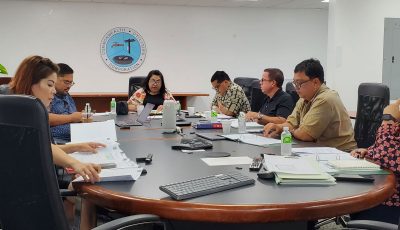LAWMAKERS TELL CUC OFFICIALS:
‘RO system not the magic bullet to CUC water woes’
House lawmakers heard from local utilities company officials on power and water issues during a hearing on Capitol Hill yesterday and widely criticized their plans for a reverse-osmosis system.
Some lawmakers challenged the Commonwealth Utilities Corp.’s priorities, pointing to the utilities company’s 70 percent in unaccounted for water and while some board members touted the RO treatment plans, the board also cautioned the plans were still being debated.
Nevertheless, the $160 million to construct the RO plant, funding for which would be financed through taking on debt, was still challenged.
“You’re saying there is one magic bullet. I beg to differ,” said House vice speaker Joseph Deleon Guerrero (Ind-Saipan), responding to CUC board member Ignacio Perez after he touted the RO plans. “The problem with RO is that no matter how cheap it is we are going to be charged per gallon and those are going to be charged to our customers.
“So consider other options,” the vice speaker added, “before you decide to go with one magic bullet.”
Guerrero said over the years, the House has had all kinds of experts come up with all kinds of solutions to them. He noted an early Army Corps of Engineer study done several years ago that proposed over 20 recommendations on how the CNMI could address the water issue, with some being very costly and some practical,
He noted the RO plan was in the report. “I don’t think it is ranked high up there. I do believe we need to fix our leaks. We can’t supplement our water, then lose it,” especially with the RO system where customers would be paying per gallon.
Guerrero wanted to know if CUC was systemically approaching water leak issues.
CUC chief engineer for water and wastewater John Riegel said Saipan’s system was complicated, with its changes in topography from Beach Road to Mt. Tapoachau. And said CUC has approached leaks tank service area to tank service area, starting with an area that shows a great amount of leakage, from higher leaks to lower.
They started at Dandan, according to Riegel, and the San Vicente and will then move down to Koblerville, As Matuis, then Garapan. But he also stressed the only money we get to put into the effort is “from a couple of small EPA grants.”
“Yes. We are systematically approaching it,” Riegel said, responding to the vice speaker. “We do have a game plan.” He also said they would be able to “quantify” whether losses came from leakage, theft, or unaccounted for water to rectify water billings.
Rep. Edwin K. Propst (Ind-Saipan) also shared the vice speaker’s sentiments on “having priorities.” “When we heard about this RO system, there was a lot of questions and there continues to be a lot of questions,” Propst said.
“Is the RO system the answer to our prayers and it will solve all our problems with regards to water?” he added, going on to relay constituents’ complaints about why there were only three hours of water a day where they lived or why was their “water trickling?”
Propst believes the question is what is “the greater problem” is it with, production or distribution? “Where is our focus?” he said. At costs of $160 million to produce more water, he said he was “deeply concerned” they could talk about financing when CUC recently fired without cause its chief financial officer.
“That is scary,” he said, and in terms of court stipulated orders, he noted that CUC faces fines up to $56 million.
“$56 million in fines and we just recently fired our CFO and we are talking about RO system,” he said, going on to note vacant top utility management positions, like the executive director positions, among others, for which CUC faces fines up to $5,000 a day.
“We are moving on with RO plan when there are far greater priorities…We are operating at a 70-percent loss everyday,” he said, noting concern that the project would cost $160 million and amortized after 25 or 30 years would “balloon” to over $300 million.
“Unfortunately there is no CFO right now. It is most crucial to have a chief financial officer to answer the questions that we will pose about this RO system.”
Propst also warned against any sole-source contracts that could be awarded for this project.
Responding to Propst, CUC board director Eric San Nicolas said there was “no hidden agenda” and that they inherited issues longstanding for 25 years.
“I do not support anything that will raise rates,” he said.
Noting the $26 million the central government owes CUC, San Nicolas said, “I challenge every congressman to draft an appropriation to address that consistently on a monthly basis.”
He said the board is entertaining “real incremental solutions because we don’t have all the finances” and that an RO system was possibly one of them but “we haven’t made a decision…we continue to debate.”
“We have so many backlash from the media,” San Nicolas said, going on to complain that a CUC fuel contract signed with Mobil Oil Marianas several years was “never controversial” and “it went through.”
“Take those two and compare. The $370 million was never controversial, it went through, and yet a potential that hasn’t even been entertained by the board” has been, he said.
He pleaded lawmakers to address the government’s debt to CUC.
During his presentation, CUC acting executive director Gary Camacho made a Power Point presentation on, among others, CUC’s water distribution issues.
A “possible solution?” A 6-million gallon RO to meet current and future water needs, according to his report.
The system would meet U.S. Environmental Protection Agency standards and would be located at Lower Base adjacent to CUC’s Power Plant 1, the report said. CUC deems this the best location due to its close proximity to water wells, brine injection wells, and existing fuel storage facilities.
The plant would be housed in a concrete structure designed to withstand 175 miles per hour wind load and would include full power from rebuilt generators from Power Plant II, Camacho’s report said.
An existing 9-million gallon below grade tank at Sadog Tasi would also be rehabilitated for storage and the RO plant could be expanded at any time to 9 million gallons to meet future demands.
CUC proposes to enter into a private public partnership. Financing the project through issuance of certificates of participation issued by public partner at an anticipated interest rate of 5 to 7 percent.
Debt would be capitalized for three years and principal deferred for another two years, the CUC report said.
This means CUC plans to make no payments until the beginning of the third year of RO operation.
CUC said the three years would allow system improvements, needed rate adjustments, and improved cash flows before payments begin.



























